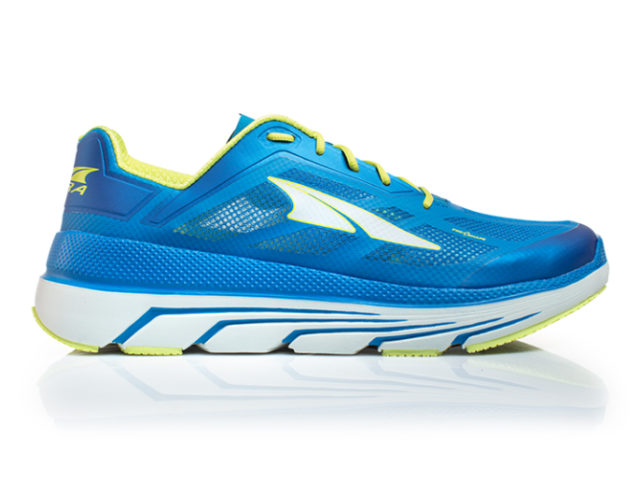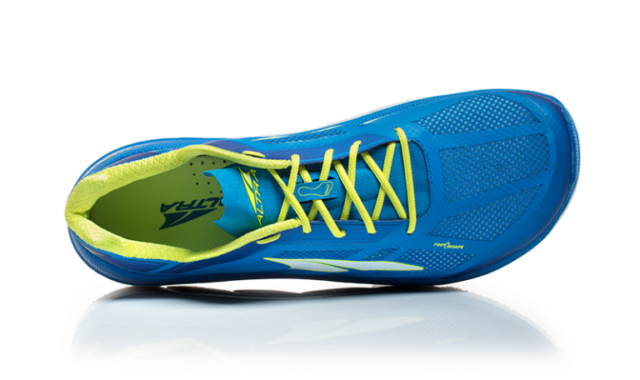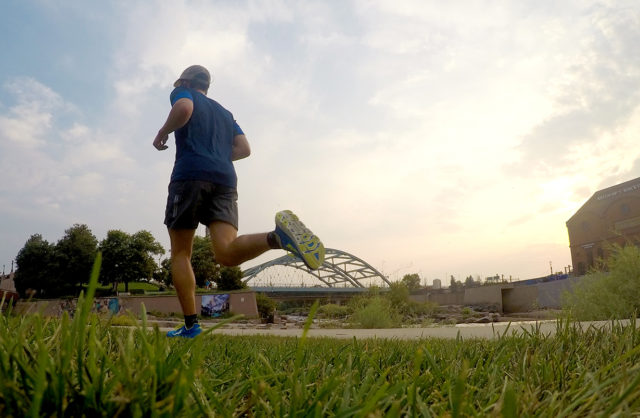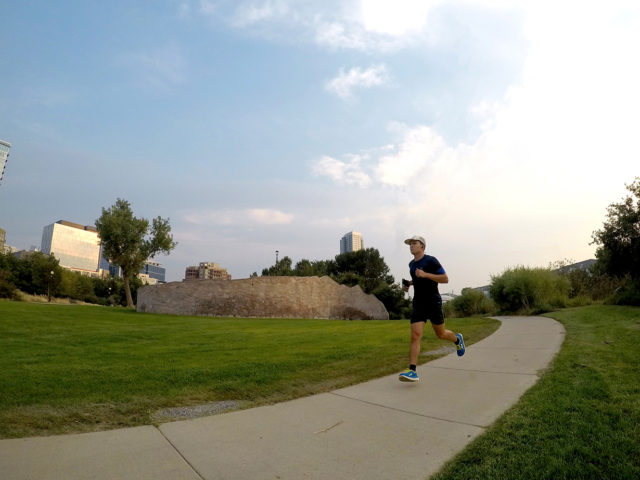
Altra Duo
Stack Height: 30 mm (heel); 30 mm (toe)
Drop: 0 mm
Stated Features:
- Insole: 6 mm Contour Footbed
- Platform: FootShape™ Toe Box, Cushioned Zero Drop™
- Stack Height: 30 mm
- Midsole: Lightweight injection molded foam
- Outsole: Blown rubber with full contact
- Upper: Thin and reinforced, breathable upper
- Other Features: Nubuck pillow tongue, DriLex lining
MSRP: $130
Size Tested: 10
Blister’s Measured Weight (size 10):
- Shoes + Laces (no insoles): 235 & 238 g
- Insoles: 17 & 17 g
- Total Weight: 252 & 255 g
Test Locations: Front Range, CO
Test Duration (So Far): 25 miles
Reviewer: 5’8”, 155 lbs. (my running background and preferences)
Intro
The words “max cushioned,” “extremely lightweight,” and “race-ready” aren’t often thrown around together when describing one shoe. Usually you either get a shoe with a bunch of cushioning, or you get a super light and efficient racing shoe.
But Altra says their new Duo shoe bucks that trend, and they specifically say that, “with the Duo “you get a super lightweight, fast, max cushioned racer.”
I’ve now spent enough time in the Duo to get a pretty good idea of how it performs, and so far, I think Altra is pretty spot-on with their description.
So, what does a “super light, fast, max-cushioned” racer feel like when you hit the road?
Weight + Comparisons
Compared to other shoes with stack heights roughly around 30 mm, the Duo is very light. And while I’m used to running in maximalist shoes and don’t tend to notice their heavier weights, running in the Duo immediately made it apparent that it is a very light shoe. It’s funny running in this shoe and feeling like I barely have anything on my feet, then looking down and seeing the Duo’s giant midsole.
For reference, here are a few of our measured weights (per shoe, in grams) for some relevant shoes.
252 & 255 Altra Duo, size 10
295 & 306 Hoka One One Clifton 5, size 10
297 & 297 Hoka One One Speedgoat 2, size 10
335 & 337 Altra Timp, size 10
333 & 348 Altra Olympus 3.0, size 10
333 & 357 Hoka One One Stinson ATR 4, size 10
Drop
The Duo — like all of Altra’s shoes — has a stated heel-to-toe drop of zero. This is one of the most noteworthy characteristics of the Duo, and will be an important consideration for a lot of people.
I really like shoes with minimal heel-to-toe drops. They are designed to allow for a more natural stride, and allegedly lead to lower-impact foot landings (which I’d say is true given my experience with the Altra Timp and Altra Olympus 3.0). But if you’re coming from shoes with higher drops (8-12 mm), then we’d strongly encourage you to check out Altra’s transition plan if you decide to switch to a zero-drop shoe.
Zero-drop shoes require a pretty significant change in running style and not doing so can result in injury, so it’s important to keep that in mind if switching from shoes with more traditional heel-to-toe drops.
Fit
As always, we recommend trying on any shoe before buying it. But with that said, I can offer my thoughts on how the Duo fits my foot (I’m reviewing it in my customary running-shoe size of 10). For reference, I have pretty average-volume feet, but I have large lateral splats which mean my midfoot widens when I am standing / running. I also have a fairly low instep. I prefer shoes with wider midfoot areas since that’s where I most commonly experience pain while running.
All of Altra’s shoes feature what they call their “FootShape” toe box, which flares out at the end more than most other shoes, giving your toes more room to splay out. But while the Duo is quite wide in the toe box, the rest of the shoe is a bit less voluminous.

The Duo feels a bit lower-volume in the midfoot and ankle compared to the Altra Olympus 3.0, and pretty similar to the Altra Timp and Hoka One One Clifton 5. I’d say that, in terms of overall volume, the Duo feels slightly above average, particularly in the toe box.
Upper
The Duo’s upper is extremely thin and minimal, which is part of why it’s so light (~255 grams for a size 10). The upper is comprised mostly of a really thin mesh that’s reinforced with some laminated overlays.
The result is a super airy and breathable feel, and I think the Duo is one of the most breathable shoes I’ve ever used. For runs in really hot weather, this upper is awesome.

While its upper is super thin, the Duo actually feels fairly stiff and supportive around the ankle and heel. But since the upper is so thin, I found that I could tighten down the laces a lot to get a very precise fit. The Duo’s upper doesn’t conform to my foot like some shoes with stretchier knit uppers (e.g., the Altra Escalante), but I haven’t had any complaints about the comfort of the Duo’s upper.
Midsole & Cushioning
A little backstory: the original Hoka Clifton was one of my favorite road shoes of all time. It had a stack height of around 30 mm, offered a super springy and plush ride, and was surprisingly light for how fat its midsole was. But the recent iterations of the Clifton (including the Clifton 5 that I’ve been running in and will be reviewing soon) have moved the shoe in a different direction, and feel pretty different on the road.
In my search for a replacement for the OG Clifton, I stumbled upon the Altra Duo. The Duo, apart from looking eerily similar to the Clifton (they even share pretty much the exact same colorway), is also a very light shoe with lots of cushion.
So is the Duo the shoe to finally replace the old Clifton?
Maybe, but that depends on what exactly you want from your lightweight, highly cushioned shoes.
The Duo’s midsole is not plush or squishy, and it offers very little “spring” or rebound during a stride. So if you’re looking at the Duo’s stated stack height of 30 mm and thinking that running in it will be like jogging through a field of pillows, think again. The Hoka Clifton 5 and Altra Olympus 3.0 both have softer, springier midsoles.
So why get a shoe with this thick of a midsole if it’s not super plush?
Because the Duo is fast. Really fast.
Since its midsole doesn’t let you sink into the shoe, the Duo feels very efficient for how much cushion it has. And while its cushioning is quite firm, the Duo isn’t super stiff longitudinally, so it can bend during each stride which helps me keep me moving (the Hoka Clifton 5 and Stinson ATR 4 are both significantly stiffer longitudinally).

While running in the Duo, I felt like I wasn’t losing much energy at all during each stride. Combine that with the Duo’s minimal upper and low weight, and I kept thinking it basically felt like a racing flat with a chunky midsole.
The Duo felt most at home when I was running at a pretty quick pace. I’d personally prefer a softer and more springy shoe for casual training runs, but if I was looking to set a PR in a shoe with a 30 mm stack height, I’d grab the Duo.
Outsole
The Duo only has rubber in the high-wear areas around the forefoot and heel, with foam everywhere else. I haven’t had any issues with grip on pavement, but in case you were wondering if the Duo could cross over to trails, I wouldn’t recommend it.

The other quirky thing with the Duo’s outsole is that its podular design tends to pick up little rocks as you plod along. Even after only running on pavement, I’d check the Duo’s soles at the end of a run and usually find a few small stones stuck in between the outsole “pods.” This is much more of a minor annoyance than a serious issue, but it’s worth noting.
Durability
I’ve only put around 25 miles in the Duo, so I’ll be posting a longer-term update on its durability after putting more miles in it. But so far, I haven’t had any issues.
I think it will be important to keep in mind the Duo’s lightweight construction — its upper is very thin, and the rubber used on its outsole is pretty minimal. This is a shoe that’s designed to be fast and light, and I don’t expect it to hold up quite as well as shoes with more substantial outsoles and uppers. But I’ll report back when I have more time in the shoe to confirm or disprove that suspicion.
Who’s It For?
If you’re interested in trying out a shoe with more cushioning but hate the squishy, inefficient feeling of soft midsoles, then the Duo is certainly worth a look. If, however, you like shoes that offer a plush, springy ride, then the Duo is not for you.
As I noted above, the Duo feels like a fat racing flat. So if you like the sound of that, give it a look.
Bottom Line
There are plenty of minimal, race-oriented shoes out there that are extremely efficient, but don’t offer much in terms of cushioning and comfort. And there are a bunch of shoes that have a lot of cushioning, but they’re often bulky, heavy, and not nearly as efficient as their less-cushioned counterparts. But the Altra Duo is a shoe that combines elements from both ends of the spectrum, and the result is an uncommon combination of efficiency, low weight, and a lot of cushioning.
